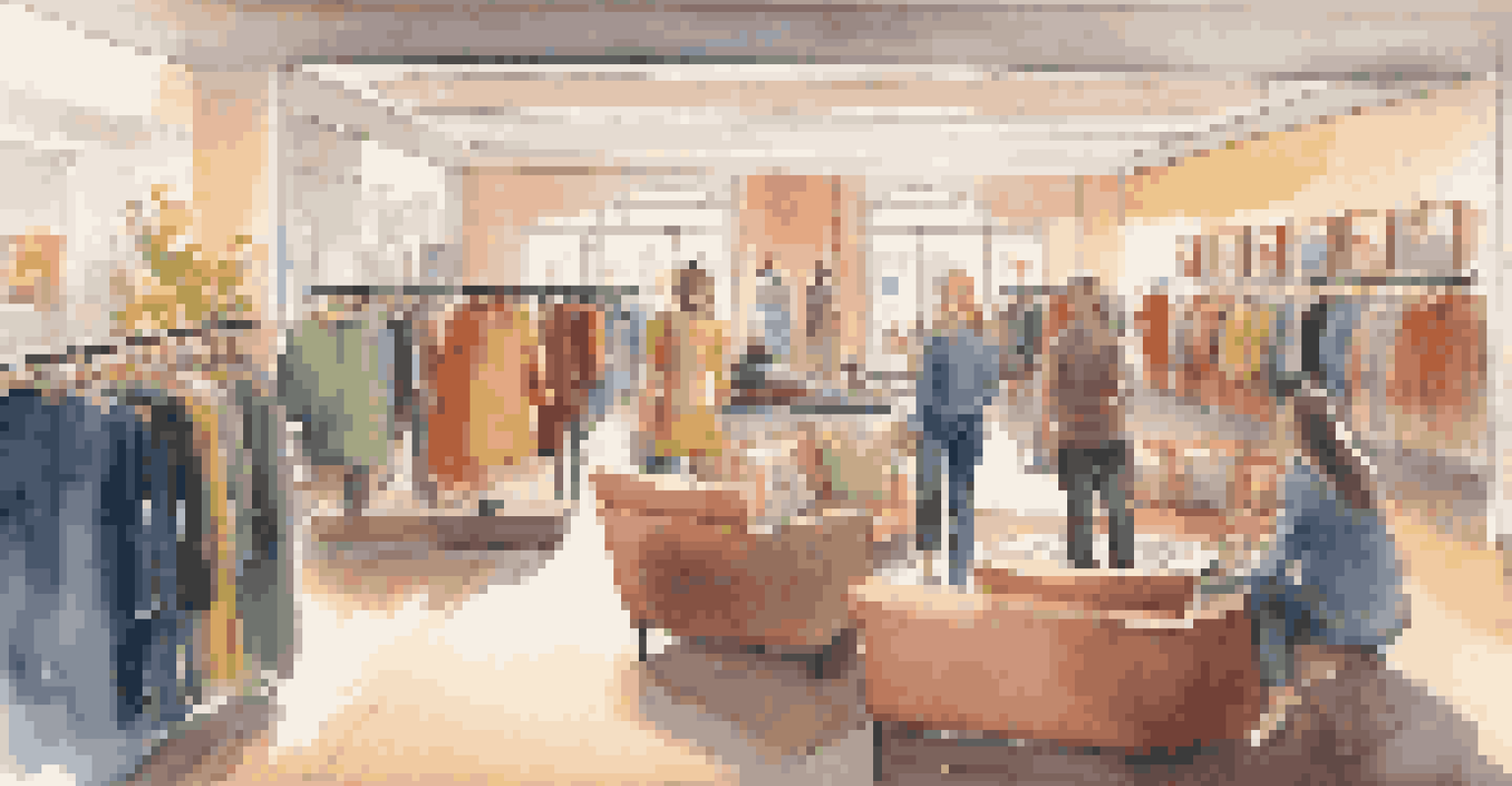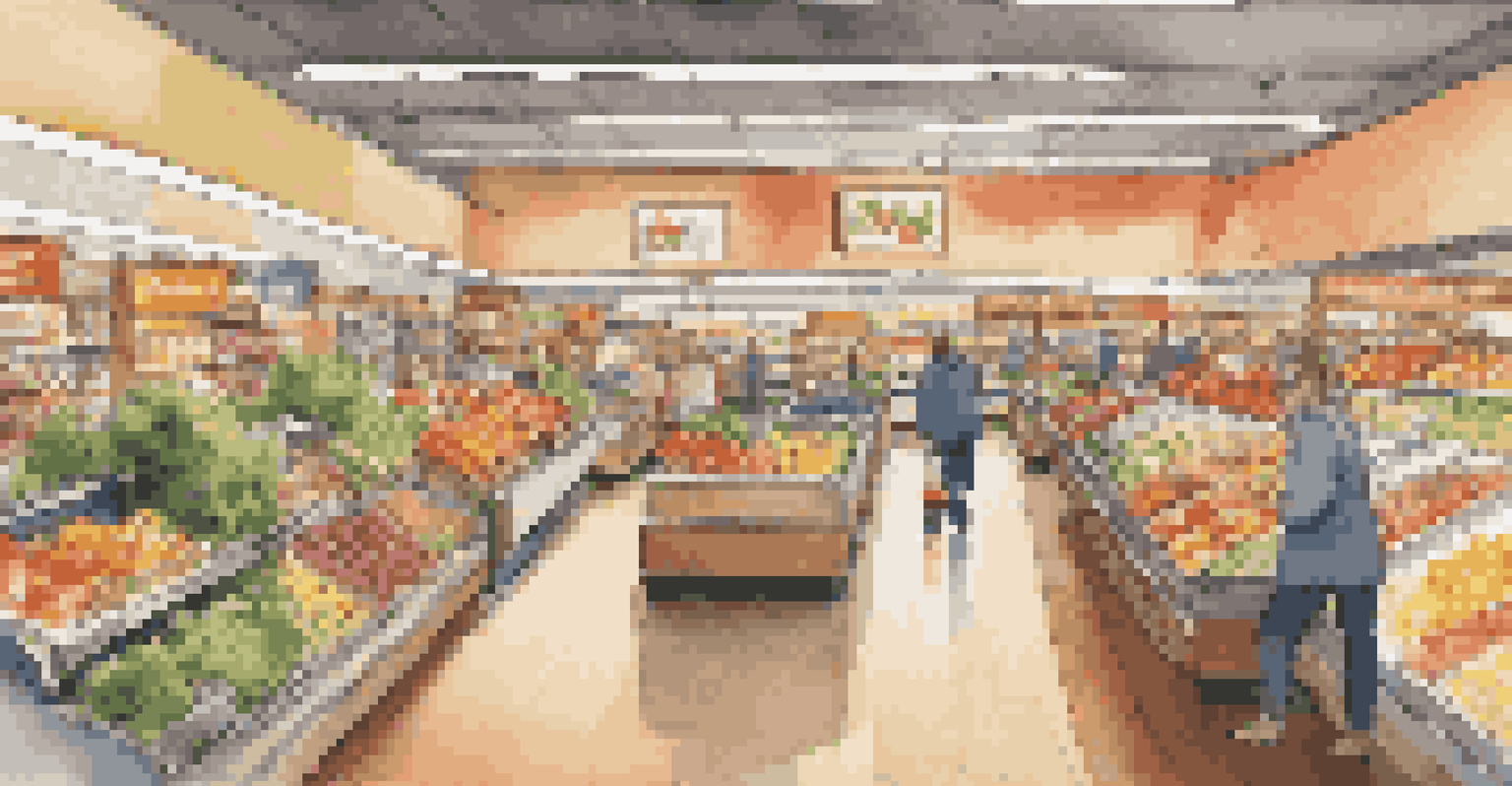The Importance of Store Layout in Retail Management Success

Understanding the Basics of Store Layout
Store layout refers to the way merchandise is arranged in a retail space. It encompasses everything from the placement of shelves to the flow of customer traffic. A well-planned layout can make shopping more enjoyable, guiding customers through the store effortlessly.
The best layout is one that not only attracts customers but also guides them through the store seamlessly.
Consider a grocery store: the layout is typically designed to lead shoppers past essentials like produce and dairy before they reach the checkout. This strategic arrangement encourages impulse buys and promotes customer engagement. When shoppers feel comfortable navigating a store, they are more likely to spend time—and money—there.
In essence, understanding the basics of store layout is crucial for retailers aiming to optimize their space. The layout not only influences customer behavior but also reflects the brand's identity and values.
How Store Layout Influences Customer Behavior
The way a store is laid out can significantly impact customer behavior and purchasing decisions. For instance, open layouts with wide aisles often encourage customers to browse, while more compact designs can create a sense of urgency. Retail psychologists suggest that a pleasant shopping environment can increase dwell time and overall sales.

Think of a clothing store where items are displayed in an inviting way, allowing customers to visualize outfits. This setup not only enhances the shopping experience but can also lead to higher conversion rates. When shoppers feel relaxed and inspired, they’re more likely to make a purchase.
Store Layout Boosts Sales
A well-planned store layout can enhance customer experience and drive impulse purchases.
In summary, the influence of store layout on customer behavior is profound. By strategically designing the shopping space, retailers can create an environment that fosters connection and encourages sales.
Different Types of Store Layouts Explained
There are several types of store layouts, including grid, racetrack, and free-form designs. Each layout serves a different purpose and caters to various types of merchandise. For example, a grid layout is common in grocery stores, while a racetrack layout is often used in department stores to guide shoppers through a predetermined path.
A well-thought-out store layout can transform a shopping trip into an enjoyable experience, boosting sales and customer satisfaction.
The free-form layout, on the other hand, is more fluid and allows for creativity in product placement. It's often used in boutique shops where the shopping experience is just as important as the products being sold. Understanding these different layouts helps retailers choose the best one for their specific needs.
Ultimately, the right layout can enhance functionality and aesthetics, driving customer engagement and sales. Retailers should consider their target market and product offerings when selecting a layout.
Maximizing Space Efficiency with Strategic Layouts
Maximizing space efficiency is one of the primary goals of a well-designed store layout. Retailers can make the most of their available space by strategically placing high-demand items at the back of the store. This encourages customers to walk through the aisles and discover other products along the way.
Additionally, effective use of vertical space, like shelving and displays, can help showcase more products without overcrowding the store. For instance, utilizing wall space for displays can keep the floor area clear and inviting. This balance can lead to a more enjoyable shopping experience for customers.
Different Layouts Serve Unique Needs
Understanding various store layouts helps retailers choose the best design for their products and target market.
In conclusion, a strategic layout not only makes the best use of space but also enhances the overall shopping experience. By focusing on layout efficiency, retailers can drive customer satisfaction and increase sales.
Creating an Inviting Atmosphere Through Design
An inviting atmosphere in a retail store can be achieved through thoughtful design choices. Elements like lighting, color schemes, and signage play a crucial role in setting the mood for shoppers. For example, warm lighting can create a cozy environment, while bright colors can energize and attract attention.
Moreover, incorporating comfortable seating areas can encourage shoppers to linger, increasing the likelihood of purchases. This approach not only enhances the atmosphere but also makes the shopping experience more enjoyable. It’s about creating a space where customers feel welcomed and valued.
Thus, the design of a store layout goes beyond mere functionality; it’s about crafting an experience that resonates with customers. An inviting atmosphere can lead to repeat visits and loyal customers.
The Impact of Seasonal Changes on Store Layout
Seasonal changes can greatly influence store layout and merchandising strategies. During holidays, for instance, retailers often modify their layouts to highlight seasonal products, promotions, or themed displays. This not only attracts customers but also creates a sense of urgency to purchase seasonal items.
Consider how a store might rearrange its layout for back-to-school season, prominently displaying supplies near the entrance. By adjusting the layout to reflect seasonal trends, retailers can capture the attention of shoppers looking for specific items. It’s a dynamic approach that keeps the shopping experience fresh and relevant.
Seasonal Changes Require Flexibility
Adapting store layouts to seasonal trends is crucial for maintaining customer interest and maximizing sales.
In short, adapting store layouts to seasonal changes is key to maintaining customer interest and driving sales throughout the year. Retailers who embrace this flexibility can stay ahead in the competitive market.
Measuring Success: Key Metrics for Store Layout Effectiveness
To gauge the effectiveness of a store layout, retailers should consider several key metrics. Sales per square foot is a vital indicator of how efficiently space is being utilized, while customer dwell time measures how long shoppers spend in the store. These metrics can provide valuable insights into layout performance.
Additionally, analyzing foot traffic patterns can reveal which areas of the store attract the most attention. This information allows retailers to make informed decisions about product placement and promotional displays. By continuously monitoring these metrics, retailers can refine their layouts for optimal results.

Ultimately, measuring success through these metrics enables retailers to adapt and improve their store layout over time. This ongoing assessment is crucial for maintaining competitiveness in the retail landscape.